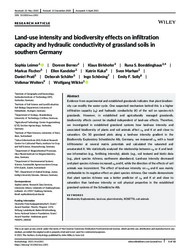Land‐use intensity and biodiversity effects on infiltration capacity and hydraulic conductivity of grassland soils in southern Germany
Berner, Doreen
Birkhofer, Klaus
Boeddinghaus, Runa S.
Fischer, Markus
Kandeler, Ellen
Kuka, Katrin
Marhan, Sven
Prati, Daniel
Schäfer, Deborah
Solly, Emily F.
Wolters, Volkmar
DOI: https://doi.org/10.1002/eco.2301
Persistent URL: http://resolver.sub.uni-goettingen.de/purl?gldocs-11858/9840
Persistent URL: http://resolver.sub.uni-goettingen.de/purl?gldocs-11858/9840
Supplement: http://doi.org/10.17616/R32P9Q
Leimer, Sophia; Berner, Doreen; Birkhofer, Klaus; Boeddinghaus, Runa S.; Fischer, Markus; Kandeler, Ellen; Kuka, Katrin; Marhan, Sven; Prati, Daniel; Schäfer, Deborah; Schöning, Ingo; Solly, Emily F.; Wolters, Volkmar; Wilcke, Wolfgang, 2021: Land‐use intensity and biodiversity effects on infiltration capacity and hydraulic conductivity of grassland soils in southern Germany. In: Ecohydrology, Band 14, 6, DOI: 10.1002/eco.2301.
 |
Dokument öffnen: |
Evidence from experimental and established grasslands indicates that plant biodiversity can modify the water cycle. One suspected mechanism behind this is a higher infiltration capacity (νB) and hydraulic conductivity (K) of the soil on species‐rich grasslands. However, in established and agriculturally managed grasslands, biodiversity effects cannot be studied independent of land‐use effects. Therefore, we investigated in established grassland systems how land‐use intensity and associated biodiversity of plants and soil animals affect νB and K at and close to saturation. On 50 grassland plots along a land‐use intensity gradient in the Biodiversity Exploratory Schwäbische Alb, Germany, we measured νB with a hood infiltrometer at several matrix potentials and calculated the saturated and unsaturated K. We statistically analysed the relationship between νB or K and land‐use information (e.g., fertilising intensity), abiotic (e.g., soil texture) and biotic data (e.g., plant species richness, earthworm abundance). Land‐use intensity decreased and plant species richness increased νB and K, while the direction of the effects of soil animals was inconsistent. The effect of land‐use intensity on νB and K was mainly attributable to its negative effect on plant species richness. Our results demonstrate that plant species richness was a better predictor of νB and K at and close to saturation than land‐use intensity or soil physical properties in the established grassland systems of the Schwäbische Alb.
Statistik:
ZugriffsstatistikSammlung:
This is an open access article under the terms of the Creative Commons Attribution‐NonCommercial License, which permits use, distribution and reproduction in any medium, provided the original work is properly cited and is not used for commercial purposes.

